Let X T be a topological space If C X D X and C D then Ext
Let (X, T) be a topological space. If C X, D X, and C D = , then Ext(C) Ext(D) = .If True give a proof and if false give a counterexample. Ext is the exterior of the subset.
Solution
Let us recall a few definitions of related to topological spaces namely, the interior and the exterior of a set and neighbourhood of a point in a topological space.
If X be any non-empty set and T be a collection of subsets of X satisfying certain criteria, (X,T) is called a topological space.
A point p in a subset A of X is said to be an interior point of A in the space (X,T), if there exists a subset B of X in T such that p blongs to B and B A. The set of all interior points of A is said to be interior of A and the set of all those points of X which are not in interior of A , is called exterior of A.
Suppose C X and D X such that they have no elements in common. Then the statement that Ext(C) and Ext(D)
will also be disjoint, is false. It may understood with the help of following example:
Let us now consider a set X = {a,b,c,d,e,f,g}, and a topology T={{a,b},{a},{c},X, the empty set (\\phi)} and two of its disjoint subsets C and D as C={d,e} , D={f,g}. Then, by definition, int (C)=\\phi, so that Ext(C) = X - int(C) = X, int (D) = \\phi, which means Ext(D) = X - int (D) =X. Clearly, Ext(C) and Ext(D) are nto disjoint.

 Homework Sourse
Homework Sourse